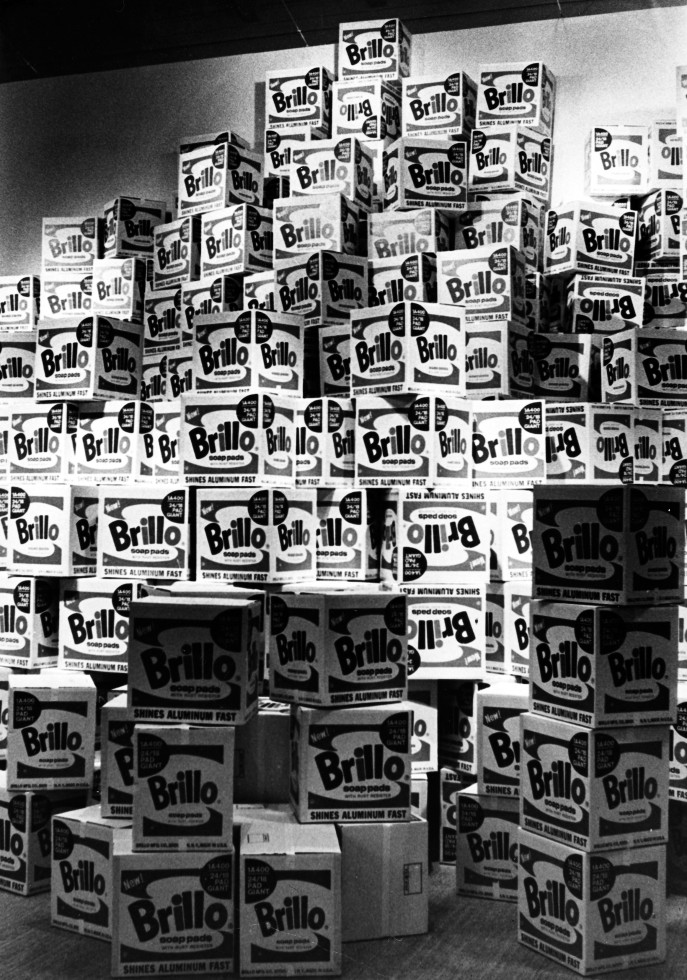
Brillo Soap Pads Boxes at Warhol’s retrospective at the Moderna Museet, Stockholm, 1968 – photograph: Nils-Göran Hökby/Moderna Museet
The phrase famous for fifteen minutes and variants mean briefly famous or notorious, before fading back into obscurity.
They refer to the following quotation attributed to the American painter, graphic artist and film-maker Andy Warhol (Andrew Warhola – 1928-87) in the book published for the first European retrospective of his work at the Moderna Museet, Stockholm, Sweden, from 10th February to 17th March 1968:
In the future everybody will be world famous for fifteen minutes.
However, the Swedish art critic and museum director Olle Granath (born 1940), explaining in With Andy Warhol 1968 how the exhibition was organised, writes (the Swedish art collector and museum director Pontus Hultén (1924-2006) curated the exhibition):
There was also to be a section of texts. One day, Pontus brought me a box, almost the size of a Brillo box, and told me that it contained everything written by and about Andy Warhol (today the equivalent would probably be two truck loads). My job was to read it all and present a proposal for a manuscript with Swedish translations. After a couple of nights of reading and taking notes I delivered a script to Pontus and awaited his reaction with great anticipation. ‘Excellent,’ Pontus said when he called me, ‘but there is a quotation missing.’ ‘Which one?’ I said. ‘In the future, everyone will be world-famous for 15 minutes,’ Pontus replied. ‘If it is in the material I would have spotted it,’ I told him. The line went quiet for a moment, and then I heard Pontus say, ‘If he didn’t say it, he could very well have said it. Let’s put it in.’ So we did, and thus Warhol’s perhaps most famous quotation became a fact.
The earliest use of the phrase without explicit reference to Andy Warhol that I have found is from the following by Stanley Reynolds, published in The Guardian (London) on 15th October 1973:
I love rich-looking glamorous dames who wouldn’t look at me twice because I obviously don’t know my St Trop from the backside of a Blackpool boarding house, and really honkey-tonk trash dames of the we-wear-short-shorts and hand rock motor bike school, who wouldn’t look even once at a guy with no tattoos. But most of all I love little cuddly dolly birds who look as if they haven’t had a thought in their heads since a week ago last Tuesday when they agonised for three hours over going for ruby lips instead of garnet lips or amber lips or dark pearl amethyst lips and what that was going to mean to the colour they painted their eyes.
Well, it is an agonising reappraisal that. And being young and pretty is a talent. Who is going to record the dolly bird’s days of excellence? How quickly the memory of it fades. That curve of the cheekbones which had the power to break your heart, the little voice saying perfunctory sentences, little yeses and noes, soon it is all over. You see the faded dolly birds in their cloth coats standing in the chemist’s waiting to get their tranquillisers. They daydream about the soft look their eyes once had.
Rich girls get more money, tough ones gee [sic] harder, intelligent ones wiser, but the poor little dolly birds just fade away. I’d like to go down to Zandra Rhodes, to Ossie Clark’s, to Biba’s, Jean Muir’s, Varon’s, St Laurent’s, Jap’s, Laura Ashley’s and get great armloads of red and plum, black and violet, silk crepe and velvet, chiffon in knife pleats, ivory mink smocks, quilted satin blazers, cloche hats with dotted veils, bundles of enamelled bangles, and race out and give them away to the little dolly birds and take all their photographs in all the colours of the rainbow for all the high grade, high gloss magazines and make everyone [sic] of them famous for 15 minutes.
